|
LUMBERING In three quarters of a century, two major
industries have enveloped this northern community, "Timber
to Taconite" is Nashwauk's history. Small scale logging began as far back as
1880. Our area was originally a vast forest. Before early
settlers could legally purchase timber claims, some sort of
settlement had to be made with the Indians. The first
Indians in this area were the Sioux, who later were driven
out by the Chippewa. It is historically recorded that a
trader by the name of Coran made friends with some of the
Chippewas in the Nashwauk, Swan Lake and Goodland areas. In
fact, Chief Lightfoot's tribe camped at Indian Point, Swan
Lake, and also at O'Brien Brook, which now has been made
into a tailing pond by the Hanna Mining Company.
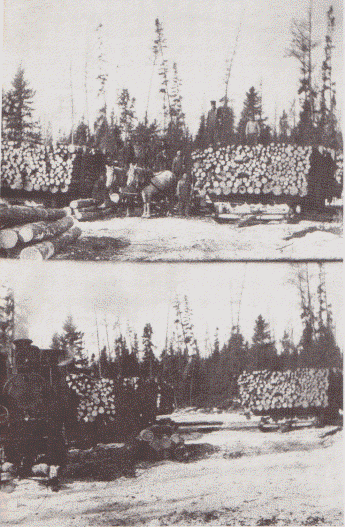
Top picture shows horse loading and
yarding" in the woods, the latter term meaning pulling loads
together. These loads were hauled by the Sturgeon Timber
Company with C.W. Latvala as manager. The trips were made
between Sturgeon Lake and Alexander. Bottom picture
illustrates a steam hauler pulling the pulpwood loads. This
engine could haul a maximum of 12 loads, but generally
carried 10. These two-tiered loads were 16 feet wide, and
ran almost a carload of wood to each sleigh. The photographs
were taken in 1912. As more and more timber was cut, lumber
camps and lumberjacks spred throughout our wooded area. A
few settlers as well as bigger companies, began culling the
heavy growth of white and Norway pines around Nashwauk in
1890. Logging was a job for the stouthearted,
strong-armed man. There were fewer accidents in the old days
probably because the men were well-trained. Men took great
pride in being able to do a job without having or causing an
accident. The only medicines used in the camps were
liniment, castor oil, vaseline, ginger, cascara pills,
carbolic salve, and later, aspirin tablets. If a man got a
cut or a scratch, he would apply balsam pitch or a chew of
peerless tobacco to it, and it would heal in a few days.
Most camps had more medicine on hand for the horses than for
the men. Good care of the horses was always a rule. Every
camp, however small, had a blacksmith, known as the "iron
man." Besides taking care of the horses, he also repaired
the equipment. The lumberjacks were adequately cared for,
well-fed, warmly dressed, and had suitable places to sleep.
Most camps had saunas; and though bathroom facilities were
outdoors, everything was kept as clean as possible.
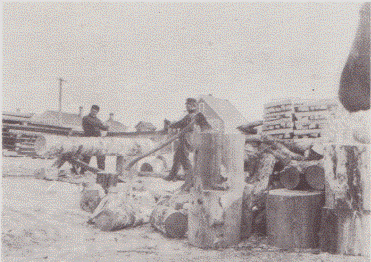
Cutting wood in 1908 site of former elementary
school. Whenever a picture is shown of a large
load of logs being hauled by a single or four-horse team,
the question is asked, "How could just a few horses pull
such a large load of logs?" The answer a lot of effort was
put into the laying out and maintaining of the ice roads for
logging and into the construction of the sleighs. As
lumbering increased work became more organized. Choppers dropped trees, sawyers cut them
into lengths, swampers cleared away the brush and small
trees, loaders piled the logs on sleds, teamsters hauled
them to the river bank, crews kept the logs moving down the
rivers, and jam crews broke jams of piled up logs. Their job
was to find the key log, yank it loose, so that the other
logs could keep rolling. The sacking crew did the cold and
dirty work of picking up stray logs that got hung up in the
brush or caught on sand bars often wading in muck and ice.
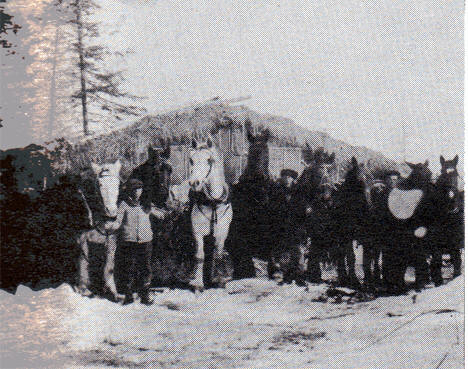
Pictured are teams of horses
used in early logging operations in Nashwauk
In the early lumbering years, long iced
roads were used to haul the logs to streams. Railroads had
hauled lumber from the sawmills to the markets, but no one
thought that logs could be hauled out of the woods by
railroad. They were built, but were makeshift facilities.
Derailment was not unusual; but while they lasted, the
railroads hauled millions of logs out of our county. The Wright Davis Company was operating
around Nashwauk before 1900. The Smith Saw Mill Company of
Minneapolis cut many trees between Nashwauk and Keewatin and
down to Swan Lake. The Bovey-DeLaittre Company cut to the
west and northwest of Nashwauk. The Power-Simpson Company of
Hibbing operated to the north as far as Crooked Lake. For
about ten years, thirty to fifty million board feet of pine
were taken out of the Nashwauk area. The very first logging camps in Minnesota
were more or less family affairs, with brothers, cousins, or
neighbors forming the crew. As camps moved further into the
woods, men came from farms, homesteads and sawmill towns. By
1910 the big logging companies finished their work and
dismantled their many camps around the Range towns. Within a
few years a second crop of timber, such as spruce, balsam,
cedar, tamarack and jackpine was being cut in quantities by
smaller outfits. Small sawmills became quite numerous. The
logging industry entered a new era, yielding to the new
developments in our country. There was a great demand for
paper and construction lumber. Mechanical equipment replaced
hand labor. Since the fifties, logging has been completely
mechanized. Trees are felled by shears and chain saws,
skidded out of the woods by skidders with grapples or
winches on them; yarded to landings in tree lengths. These
are either cut into pulp, or fed into tree length chippers.
Most wood is handled by hydraulic knuckle boom loaders
mounted on trucks.
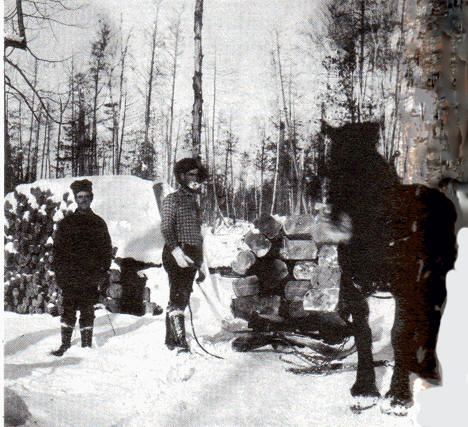
Axel Morency and Joe Gauvreau shown skidding
logs. The old logging camps which once dotted
the Minnesota woods are gone. Most loggers commute daily to
their logging operations from their homes. The timber industry of Minnesota is the
state's third largest industry. The logging of pine and
spruce has given way to the harvesting of aspen. The loggers
of today known as harvesters of Minnesota's tallest crop.
They firmly believe that trees are a renewable resource.
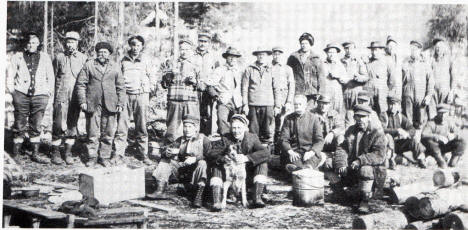
Typical early logging camp One of the first logging firms in our area
was Charles W. Latvala, succeeded by Latvala Brothers,
Richard and Robert, with a permanent sawmill located at the
site of the second Hawkins washing plant; Vincent Bianchini,
succeeded by son, Peter, dissolved a few years ago; Alex
Clusiau, succeeded by sons, Kenneth and Terrance, site seven
miles north on Highway 65; Wayne Paakkonen, permanent
sawmill, retired in 1978; Carl and Milton Manners built the
Keewatin sawmill near Welcome Lake, later acquired by the
late Roy A. Johnston and Carl Dahlberg, now retired. Other
area firms are Chester Moellering, Bruce Tillotson, and
Larry Haigh. A number of miners and farmers also harvest
pulpwood as a side line. The day will never come again when logs
will jam the rivers or be piled high on sleighs. The
glamorous days lumbering, the courage, the grit and hard
work of the pioneers are gone. The trees are coming back
again are growing on hundreds of tree farms, on thousands
of acres of state, county and industry owned lands. Tomorrow
the trees will have grown and once again will tower high in
the Nashwauk area.
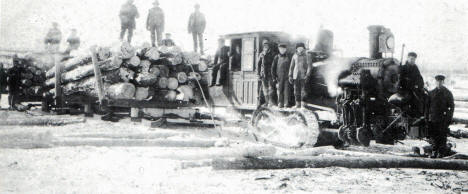
Photograph shows early logging operation of a
steam hauler pulling a load of logs.
FARMING As the first lumbering period neared its
end, the farming area north of Nashwauk was rapidly
developing. In 1915, farming lands were advertised at twelve
to fifteen dollars per acre, two and one half to five miles
north of Nashwauk on good roads. In 1916, farmers in the
vicinity of Nashwauk started preliminary proceedings towards
the organization of a Federal Loan Association to help in
the development of farm lands to the north. The Cloverdale
farm settlement had forty prosperous farmers in the 1920s,
most of them dairy farmers. The majority of these farmers
came in 1915-1918. J.J. Hansen is said to be the first
farmer in this area. He came in 1913. The present Town Board
officers (1978) are: Supervisors, Joseph Mazar, Larry Laakso,
and Armas Yuhala; Clerk, Eben Henderson; and Treasurer, Mary
Wright. Mr. Henderson has held this position for over forty
years. Mr. Mazar has served 18 years as township supervisor.
MINING
Lumber first attracted men to the area,
iron ore made them stay. It was these hard working people
who dug out of the earth around Nashwauk, great holes, the
Hawkins, LaRue, Crosby, Harrison, Quinn, Patrick, Kevin, and
York mines. Hundreds of millions of dollars in payrolls have
poured through the industrial channels of this community the
past seventy-five years. This is credited to the vision,
ingenuity, and creative ability of these early leaders in
the mining industry that has brought us to the new
threshold, that of the taconite industry.
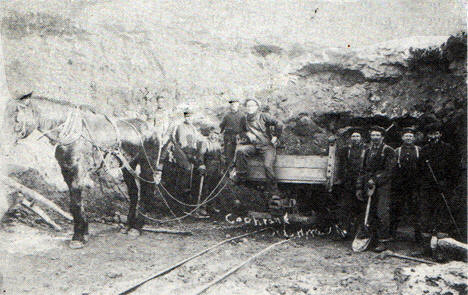
The first operation at the
Hawkins Mine in 1902 were underground with equipment as
shown here.
One cannot write about the history of
Nashwauk without mentioning the Hawkins mine, even though it
is no longer in existence today. The first iron ore mine in
Itasca County was opened in 1902 soon after the Great
Northern Railway completed a railroad from Kelly Lake to
Nashwauk. In the late fall of 1902 a spur was built to the
mine. The McArthur Brothers were the contractors for
stripping which began in 1903. Ed Brown brought the first
steam shovel to the mine in 1903, and was its first
operator. Ore was shipped that same year. Miners came and
camps were set up. These camps were tarpaper shacks with
crude conveniences. The Hawkins ceased operations July 19,
1962, after sixty productive years. Exhaustion of the ore
reserves necessitated the closing of the Hawkins mine
operated by Cleveland Cliffs from 1947 until its closing.
The mine had been one of the great producers on the Mesabi
Range. From the time the mine was first opened in
1902 by International Harvester Company up until 1962
approximately, twenty-five million tons of ore had been
shipped from the Hawkins mine. The discovery of the Hawkins reserve was
made in 1900 by the Itasca Mining Company. At that time the
property was held by the Deering-Harvester Company which
later merged with the International Harvester. The growth of Nashwauk from a fledging
newly incorporated community of 220 people in the midst of a
towering forest of virgin pines in 1902 to a modern village
was largely due to the Hawkins and later on to several other
mines in the adjacent area. A washing plant was constructed in
1910-11, approximately two miles south of the mine, costing
$700,000. It was the first in the Nashwauk area and one of
the first of two such plants on the Western Mesabi Range.
Captain Batchelder was an engineer in the first plant
construction. and was later associated with the operation at
the Hawkins mine The original plant was used until 1952 when
Cleveland Cliffs constructed a new plant adjacent to the
pit. Standing on the observation platform on
the western end of Central Avenue, looking into the now
deserted, silent cavity which once bustled with activity,
there comes to mind the saying "Old soldiers never die, they
just fade away" but what happens to a mine only time will
tell.
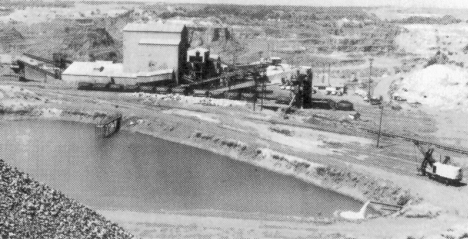
The Hawkins plant, Nashwauk Minnesota, as it
appeared in 1957
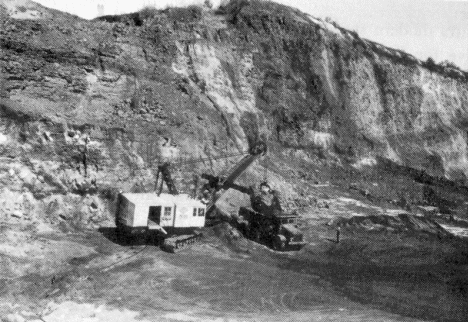
North Bank of the Hawkins Mine, Nashwauk
Minnesota, October, 1957. Cleveland Cliffs was only a season behind
International Harvester. Both began sinking shafts about the
same time. Cleveland Cliffs opened the Crosby, and the LaRue
Mining Company opened the LaRue mine in 1903. Two years
later Hanna Mining took over the LaRue. This mine was first
an underground, then an open pit.
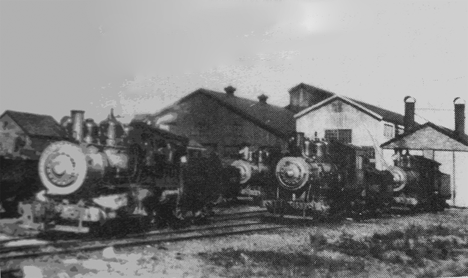
Hawkins shop about 1919-1920 Hawkins mine
did locomotive repair for Winston Deere.Butler Brothers made their first entry into the area in 1908
when they contracted to strip the LaRue, an underground
property here. Butlers had their headquarters in the
Nashwauk area until 1948 when Hanna Mining took over their
operations. In 1913 Butler Brothers took out their first leases in
the Nashwauk area at the Quinn, Harrison, and North Harrison
mines. The footings for the Harrison concentrator were
poured in 1914. This same year Butlers first shipment of
iron ore was made. The Quinn-Harrison together produced
206,080 tons in 1914. More leases were acquired and another concentrator was
built at the Patrick mine in 1917. A shop building was
constructed at First Harrison in 1915. The first electric
arc welding machine was introduced in the shops in 1925. In
1929 a mechanical department moved into a newly-erected
ultra modem shop complete with locomotive pits, a
twenty-five ton overhead traveling crane, central heating
system, warehouse, and other modem up-to-date equipment. An
electric shop and tire repair facilities were added later. By 1940 large trucks had replaced the locomotives to such
an extent that the pits were no longer needed. They were
replaced by complete automotive maintenance equipment. Butler properties in the Nashwauk area included: The
Patrick-Kevin group: Kevin, Langdon 1929-1939; David,
Patrick 1917; Ann 1929; West Patrick 1933; Patrick Annex. The Kevin was the first to be opened in this group with
shipment of iron ore made in 1916. The Patrick concentrator
was erected in 1917. When jigs were installed in the Patrick
plant in 1929 a large quantity of low grade ore material was
made available for concentration. The Kevin was the first mine to be converted from steam
haulage to truck haulage in the fall of 1937. In 1941 a
screening plant was installed in the pit, and conveyor belts
delivered' the ore to the surface. In 1942 conveyor belts
were extended to the Patrick plant. This eliminated
locomotive haulage entirely. Harrison Group: Quinn, Harrison 1914; North Harrison
1915; Harrison Annex, North Harrison Annex 1925; Halobe
1930; Snyder 1935; Mace No. 2. This group operated with steam shovels and locomotives
until 1930. That year the first electric shovel was set up
at the Harrison group. By 1938 pit haulage was changed to
truck The Harrison concentrator, constructed in 1914, was the
first Butler Brothers washing plant. It later became a cone
and double classification unit. Galbraith Group: Galbraith, Carol, LaRue (in former years
the Shada). The lease on the Galbraith and Carol mines was
acquired in 1933. These properties were held in reserve
until the fall of 1940. Washing and screening plants and
conveyor galleries were built between October 1, 1940 April
1, 1941. This group was the first of Butler Brothers mines to use
truck haulage exclusively as a means of transportation. At
this mine the plant was built near the crest of the pit
making possible to use conveyor belt haulage from the pit
directly to the plant. In the fall of 1940 screening plants
were placed in all pits. The Galbraith was noted as a
proving ground for many new and novel ideas. A variety of mining methods and equipment has been used
from the early pick and shovel, horse and wagon, coal and
steam equipment, to the present day giant electric shovels,
huge rubber-tired hundred-ton diesel electric haulage trucks
powerful bulldozers, endless conveyor belts and rotary
drills to bring us up to the latest mining method
taconite. The taconite industry in Minnesota actually had its
beginning many years ago when foresighted men saw that the
natural ores would eventually be exhausted, leaving only the
low grade taconite rock. With this in mind, geologists,
researchers, operators and management all joined hands to
create the latest and necessary phase of the mining
industry. With the passage of the Taconite Amendment in November,
1964, Butler Taconite began its site preparation immediately
afterwards. Actual construction got underway the following
spring, and the plant was turned over for operation in
April, 1967. Butler Taconite is owned jointly by The Hanna Mining
Company, Inland Steel Company, and Wheeling-Pittsburgh Steel
Corporation. Hanna Mining Company is the operating agent at
Butler Taconite, located just west of Nashwauk on Highway
169. The magnetic taconite ore bodies, located in the Patrick
Langdon group of mines, are mined by conventional open pit
methods. The crude taconite is then carried on a three
thousand foot long conveyor belt to the ore storage
building. The storage building has a capacity of 120,000
tons. The taconite is moved to the adjacent concentrator
building for grinding and separation of iron and waste. Then
in the pelletizer building pellets are formed, dried,
pre-heated, and heat hardened at 2,400 degrees Fahrenheit.
The pellets are discharged into a revolving cooler, screened
and then moved to the pellet loadout stockpile area for
shipment by unit train to the ore docks at Superior. Butler Taconite is now producing quality taconite pellets
at a 2.65 million long ton annual rate. Improvements in plant capacity and product quality has
been made almost continuously since the initial plant
construction. Top management positions at The Hanna Mining offices in
Hibbing include: E. J. Maney, General Manager, Domestic Iron
Ore Division; K.R. Kuehlthau, Assistant General Manager,
Domestic Iron Ore Division; LeRoy Anderson, General
Superintendent, National Steel Pellet Company; George
Kotonias, General Superintendent, Butler Taconite. Personnel at Butler Taconite in addition to Mr. Kotonias
are: Jack H. Morrow, Mine Superintendent; Robert C.
Anderson, Plant Superintendent; Thomas S. Chanak,
Maintenance Superintendent; Leon E. Rostvold, Supervisor of
Safety and Labor Relations; Joseph M. Shea, Purchasing
Agent; Peter K. Koskinen, Superintendent of Planning and
Technical Services; Earl W. Bedard, Accounting Supervisor;
William W. Waite, Safety Engineer.
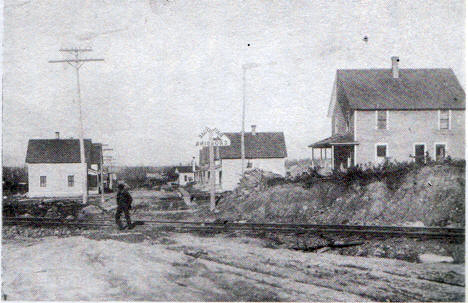
Old LaRue Location York Mine The York Mine opened in 1916. In 1942 operations were
changed from steam and locomotive to gas shovels and trucks. The York mine was taken over in 1947 by the Pacific Isle
Mining Company with Tait Siebenthal as general
superintendent and John Sandberg, acting superintendent. The
mine ceased operations here about 1954, and Pacific Isle
operations were moved to Mt. Iron.
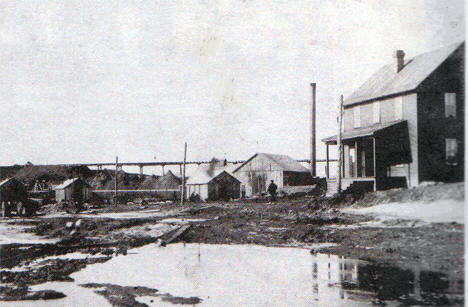
A picture of the Crosby mine in early 1900s
one of the location houses is pictured at right Lerch Brothers Lerch Brothers history goes back to the early days with
the Hawkins mine. Harry Olson, who replaced Axel Hermanson
in 1915 served as chemist in charge until his death in 1954.
Louis Swedberg and George Luckow later served in this
capacity. Lerch Brothers built a new building at Cooley and
moved its laboratory there from the Hawkins mine site in
December, 1956. This building was sold and moved in 1973 to
make way for the new four-lane highway. All operations on
the western end of the Mesabi Range were then consolidated
at the main office building in Hibbing, where they operate
today. Lerch Brothers expanded its interests into the water
analysis field in 1970, and opened a water department at the
Hibbing office building.
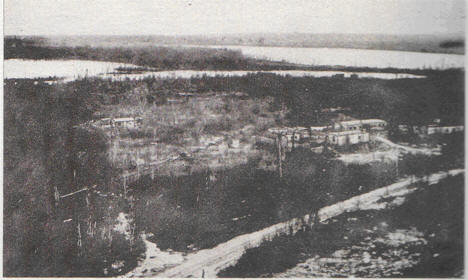
Old Patrick location which lay between the Patrick plant and
Oxhide Lake.
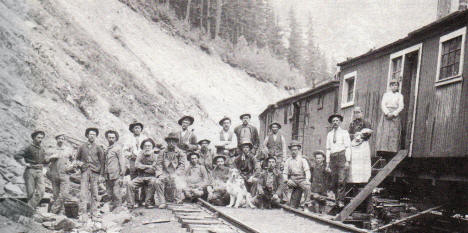
Early Hawkins Mining Camp
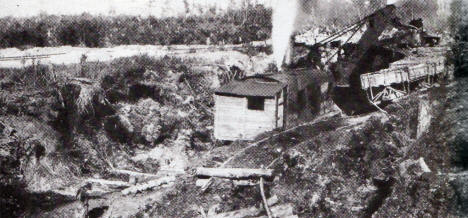
Stripping in those days was sometimes a very
rugged job. This muskeg was encountered in opening the LaRue
Mine in 1908.
Public Servants
Police Department Records of the
early police protection in Nashwauk are not available, but it is
believed that service was organized almost from the beginning.
Charles Palmquist was said to be the first chief of police. Others who
served in this capacity were Erick Forsberg, 1904: William
Hayes, 1908, and 1914-1915; Thomas Hogan. 1912; Arthur White,
191 3 ; Thomas Riley, 19151921; Philip Griffin, 1921-1924 and
1927-1933; W.J. Trythall and Harry Corwin, 1925; Henry
Henrickson, 1926; Earl Smith, 1933-1934.
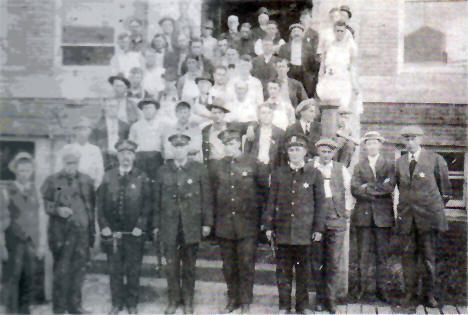
Deputies pictured here in 1916. Among those who have been
Identified are Bill Hayes, W.A. Gordon, T. T. Riley, Dan
McGuire, John Burbie, Dan McMasters, Joe DePetro, Otto Lefte,
Joe Scalise, John Koski, Dan Scannel, and Bill Crisp. Bill Hayes
was the chief of police and T. T. Riley was the sheriff Until 1936 the
village had a number of police chiefs who intruded Albert Hagen,
Charles Buccanero, William Colwell, Eli Yovetich, Carl McDowell,
and Carl Carlson. Ray DePetro
was appointed chief in January, 1937, and served in this
capacity continuously until his retirement in March 1964, 24
years of service. Robert Burns
served as chief from 1964 until December 31. 1975. when he
retired. Mr. Burns commented that he had served under five
different mayors and three county sheriffs during his seventeen
years as patrolman and chief. He holds a life membership in the
Minnesota Police and Peace Officers' Association. Joseph Sarago
served as acting chief until September 9, 1976, when Gary Clough
was named Chief of Police. Mr. Clough started with the Carlton
County sheriff's department as a part-time deputy and jail
dispatcher. In 1969 he joined
the Austin Police Department and worked there for six and half
years before coming to Nashwauk. Chief Clough received his
training from the Bureau of Apprehension, St. Paul. He joined
the Nashwauk Police Department June 1st, 1976,
and worked as a patrolman until becoming chief. He and his wife
and family reside in the former Peter Tarro home on Third
Street. The city has four full-time patrolmen, Joseph Sarago,
Don Stob, Gene Okerlund, and Mike Flatley.
|
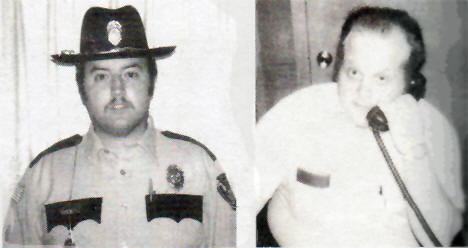 |
Chief
of Police
Gary Clough |
Civil
Defense Director
Robert Fragnito |
Civil Defense Robert
Fragnito is Nashwauk's Civil Defense Director. He has served in
that capacity for the past three years.
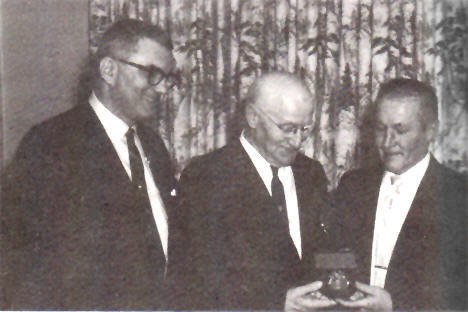
Picture was taken March 14, 1964 when Ray DePetro retired from
the Police Department. L. to R.: Sheriff John Muhar Itasca
County; Ray DePetro, Retired Chief of Police; Robert Burns,
Temporary Chief of Police.
Fire Department The need of a
Volunteer Fire Department became apparent shortly after the
Village of Nashwauk was organized. Therefore on December 1,
1903, in the post office quarters, a meeting was held to
organize a fire company for the "purpose of better preserving
the property of the village from the danger of destruction by
conflagration." Upon the
adoption of by-laws on December 15, fire fighting equipment was
acquired; hand drawn hose carts and hook and
ladder. According to old timers it was quite a sight to see the
fire lads with the fastest runners (4-10 men) grabbing the ropes
and shaft in front of the cart and the slower and older men
taking hold behind, sometimes hanging on giving added weight to
those pulling the carts. As the village
kept expanding, the longer the runs to fires, the more stamina
it took to get there. In 1914 the Department made arrangements
to pay any automobile that arrived first at the fire hall to
haul the apparatus to the site of the fire. The fall of 1916 saw
the first motorized equipment secured by the Fire Department. At first a
bell rang to call the men out and as the village grew, the sound
of the bell could not be heard by all firemen, so steam whistles
were placed on the Water and Light Plant. Soon electric power
replaced steam, and the alarms penetrated far and wide. Firemen
responded in full force. In 1917, the
department organized the present Volunteer Firemen's Relief
Association. First officers were: F.O. McCullough, C. J. Dicks,
A.G. Larson, and J.P. Lanto. Through the
relentless efforts of Marshall B. Thornton, executive secretary
of the Minnesota State Fire Department Association, the
Minnesota State legislature passed a law allocating two per cent
of all the fire insurance premiums collected in the State of
Minnesota to the Volunteer Firemen's Relief Association
throughout the state. Firemen's pensions, sickness, and
disability benefits were greatly increased. Nashwauk has
had its scare of bad fires. Three buildings were destroyed in
1909 where the present liquor store is now; in 1923 the West
Flats; and in 1942 the Nashwauk Hardware, Steve Stevens, Alex
Jaffee and Domenick Perry building were destroyed with four
families left homeless. Mine Fires: Hawkins Shop, Pearson mine
logging pit and shaft and LaRue washing plant kept volunteers
busy. In 1976 it took the full force more than forty-eight hours
to extinguish the flames engulfing the International Baths
building on Second Street. In 1962 the
village purchased a new John Bean fire truck, a combination of a
500 gallon pumper and high pressure fog. Then, Chief
Nick Dasovich, Peter Stupar, Albert Serra, and Louis Legueri
traveled to Lansing, Michigan, for operating instructions and
delivery of the new truck to Nashwauk. The City of
Nashwauk purchased another new John Bean fire truck with a 750
gallon pumper and high pressure fog in the fall of 1977 with the
aid of Nashwauk township and Lone Pine township. The new truck
is scheduled to arrive here by July 1, 1978. At the present
time there are twenty-one members on the department: Virgil
Rostvold, Chief; Milton Latvala, Assistant Chief No. 1; Peter
Saccoman, Assistant Chief No. 2; Joseph Calaguire, Secretary;
Herbert L. Latvala, Treasurer; Buddy Grozdanich, James Aimonetti,
Charles Ross, Max Benolken, Tony DePetro, Martin Stimac, Edward
Bolf, David Savolainen, Maurice Williams, Ronald Sterle, Charles
Bolf, Richard Martire, Ronald Woodman, Ernie Burns, Gary
Sweeney, and Don Stob.

RETIRED FIREMEN: L. to R.: Joe DePetro,
Pete Stupar, John Zauhar, Joe Codute, George Dasovich, I.L.
Lazzaro, Walter Schlander, Nick Dasovich, Milton Englund, Sam
Saccoman, Albert Serra, Joe Sarago, John Serra, Joe Marinaro,
Ray Crea, Louis Leguire. Missing from picture: Ray DePetro,
Louis Marter, John Zardo, Ernest Williams, Louis Sella, Walter
Forsberg. Looking over
the roster of members from the past 75 years, names of
businessmen, miners, doctors and lawyers are indelibly etched in
log books as well as in the hearts and minds of area residents.
There is something about the excitement and action of being a
volunteer fireman and most of all, the expectancy of saving
someone's life and property that keeps the interest "burning."
Attorneys Mr. Rustan has
practiced law in Nashwauk sixty years and is the only attorney
here today. He is a graduate of the University of Minnesota Law
School and was admitted to the bar in 1918. This same year he
went into partnership with Harold W. Johnston, and they opened a
law office in Nashwauk under the firm name of Johnston and
Rustan, located upstairs of the Zagar building on Central
Avenue. In 1925 his partner withdrew, and Mr. Rustan conducted
his office alone. He moved his practice to the First National
Bank building, and his office was there until 1969 when he moved
to the Chellico building. Mr. Rustan has been listed in "Who's
Who Among the Blind in Business and the Professional World."
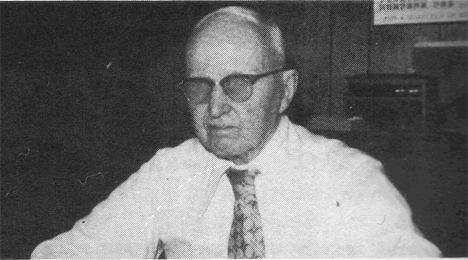
M.B. Rustan Mr. Rustan's
first wife, the former Sophia Watson, died in 1965. He was
remarried to Beth Watson, who is also deceased. Marshall B.
Thornton practiced law in Nashwauk from 1930 until his death,
December 1, 1968. Active in
church and community affairs, he served as president of the
Chamber of Commerce, was a Charter Member and past president of
the Lion's Club, a member of Range and State Bar Associations,
and a past president of the Itasca County Bar Association. He
was active in Red Cross work and served as director of the
Northland Chapter. Marshall was a retired fireman and served as
chief. At the time of his death Mr. Thornton was serving as
secretary of the Minnesota State Fire Department Association, a
position he held for fourteen years. He also served as legal
counsel to the Association. Mr. Thornton served as school and
village attorney for many years and was serving in that capacity
when he died. He was also active in the Range Association of
Municipalities. He married Bernice Ingersall of Hibbing in 1933.
Members of the Thornton family include a son, Marshall Jr.,
Duluth; four daughters Mrs. John (Rosemary) Sella. Milwaukee,
Wisconsin; Mrs. Paul (Bernie) Moreen, Mora: Mrs. Gene P. (Jean)
Malley, Pengilly, and Mrs. Thomas (Margaret) Benz, Watertown,
Wisconsin. Helen Hill
Blanz practiced law in Nashwauk from 1968 until she went into
partnership with Winton J. Mason July 1, 1974, in Grand Rapids.
Mrs. Blanz served as city attorney from 1969 to 1974, at which
time she stepped down to run for Itasca County Attorney. Mrs.
Blanz, a Swan Lake resident, is presently serving in that
capacity. Other
attorneys who have practiced in Nashwauk include: John C. Lewis,
John Gannon, A.B. Dahl, Eugene Cassidy, and John J. Benton.
Doctors The health of the community was guarded well
from the very early years with doctors and dentists serving the
people in private practice or through clinics. An ordinance was
passed by the village council in 1911 establishing a Board of
Health in the village. The first physician was Dr. Bertram S. Adams of
Hibbing who was here in 1902 and constructed the first
dispensary, a two room tar paper building on the site of the
present Hawkins pit. Part of that first summer he made the trip
on horseback and used a tent for his office. There were few
houses in Nashwauk at that time. Dr. James George joined Dr. Adams in 1903-1907.
He was followed by Dr. Charles McMann, 1907-1909. Dr. John
Shellman became associated with Dr. Adams in the Adams Clinic
until Dr. Michael Hayes arrived in 1912.
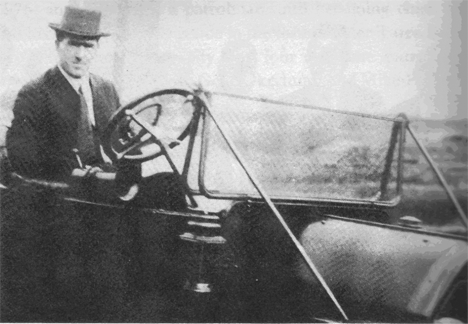
Dr. Michael Hayes, early physician in
Nashwauk Minnesota At that time, the community was already a
booming mining town, and people were in need of professional
medical services. Dr. Hayes helped make Nashwauk a healthy town
in years when the road was all "uphill." He once remarked how
people had to wait for traveling dentists to come through; and
when the pain got too severe for waiting, he sometimes had to
pull the aching tooth. Dr. Hayes served the Nashwauk area for
thirty-seven years; and until his first illness in 1944, he was
a partner at the Adams Clinic and a Hibbing General Hospital
staff doctor. He served as Nashwauk's director of the American
Red Cross for many years, was a school physician for
thirty-eight years, and was city health officer for twenty-nine
years. He served as government examining physician in both World
Wars. After forty years of service (1952), he thought it was
time to rest; though he always kept his black bag ready for any
emergency. He was married to Genevieve Gahan in 1914. He had two
children, a son Robert, who died in 1948, and a daughter
Patricia (Mrs. John Redmond), Park Ridge, Illinois. There are
eight grandchildren. Dr. Hayes died in September. 1954, after a
lingering illness. Mrs. Hayes died in July, 1971. Other early doctors were: Dr. C.N. Harris, Dr.
W.J. Hewson, and Dr. D. Sewell, the latter who built a
dispensary-hospital and physicians' residence in 1903 which was
later the Anton Hribar home on Upper Third Street. Dr. Irving
Kiesling, 1917 to about 1939, was associated with the former
Rood Hospital when they opened a branch here; this office was
established in 1916, and a physicians residence and hospital
were built in 1919. Dr. J. Webster
Raattama was affiliated with the Adams Clinic when he began his
practice here in 1949, and until his death in 1963. He received
his schooling in Nashwauk, Carlton College, and the University
of Minnesota. He served four years in the army medical
department as a biochemist and sanitary officer in the Western
Base Section of Europe. The Adams Clinic closed in Nashwauk on
July 1, 1967, after the death of Raattama. The Itasca Clinic began its practice of medicine in Nashwauk
on January 1, 1941. The first doctor was Dr. Raymond Johnson,
who was here until May 1 of that year when Dr. O.C. Braun
replaced him. Dr. Braun (married to former Rose Bonaventura)
practiced here until 1949 when he joined the clinic in Grand
Rapids. He was followed by Dr. J.S. Lewis, Dr. Roy R. Juntunen,
Dr. R.T. Kelly, Dr. K.E. Ahola, and Dr. G.W. Ireland. The Itasca
Clinic moved out of Nashwauk in 1957. The Itasca Clinic re-opened a satellite clinic here on March
3, 1978, in the rear of the Marko Bolf building on First Street
and Central Avenue. The office is open two days a week, Tuesdays
and Fridays, with seven different doctors from the clinic in
Grand Rapids serving on a rotation basis. The hope is to
establish a full-time doctor once again in the community. Dr. Larry Kruger opened the Nashwauk Clinic on July 1, 1963.
Prior to that, he was affiliated for six years with the Mesaba
Clinic and was in practice at Coleraine from 1956 until coming
to Nashwauk. Dr. Kruger practiced medicine here until he left
Nashwauk on October 30, 1971, for Hallock, Minnesota to
establish his practice.
Dentists In the early days traveling dentists served the residents of
Nashwauk. One such name mentioned was a Dr. Blix, who would come
from Duluth and spend a week here with his headquarters at the
Ollila Hotel. A Dr. Dore practiced here about 1920. Dr. Weber located in Nashwauk in 1919 and had his office
upstairs in the Zagar building for 53 years before moving across
the street in 1972 to the Englund building where he remained in
practice until his retirement in 1975. Dr. Weber was married in 1919 to Grace Carlson of Brainerd.
Mrs. Weber died in 1952. Dr. Weber was remarried in 1955 to
Mildred Grose, an elementary teacher in Nashwauk. The Weber
children include Dr. John, a dentist in Little Falls, Minnesota,
and Lois (Mrs. Harry McAllister). Westlund, Michigan. Dr. Weber
died December 1976 after practicing dentistry in Nashwauk for 56
years.
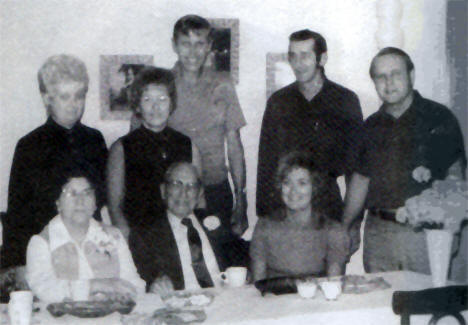
Retirement party held for Dr. O.M. Weber in 1975: Seated. L. to
R.: Mrs. Weber, Dr. Weber, Elaine Latvala. Standing. L. to R.:
Gail Gangl, Helen and Robert Buescher, Les Gangl, Herbert L.
Latvala. Dr. A.W. Craven established his dental practice here in 1924
with offices in the First National Bank building. Dr. Craven
helped organize the Nashwauk chapter of the Isaac Walton League
and was its first president. He was elected village trustee for
three terms from 1933-1942. He was a charter member of the
Nashwauk Lions Club and served as the first president of the
organization. He was married to the former May Walker. Dr.
Craven died in 1970 after 45 years of dental practice. Dr. Thomas Waite established a dental practice in the Englund
building in 1972 and was here only a short time. He was followed
by Dr. John Cornell, 1975-1976, and Dr. Paul O'Brien, who is
Nashwauk's only dentist today. Dr. O'Brien graduated from the
University of Minnesota, School of Dentistry, in 1972. He
practiced dentistry in the army at Fort Leonard Wood, Missouri,
until May, 1976. Dr. O'Brien began his practice here in June
1976. Two dental assistants have been employed by Dr. O'Brien,
since then.
Nashwauk Home |
Nashwauk Gallery
Nashwauk History
Page 1 | Page 2 |
Page 3 |
Page 4
|



